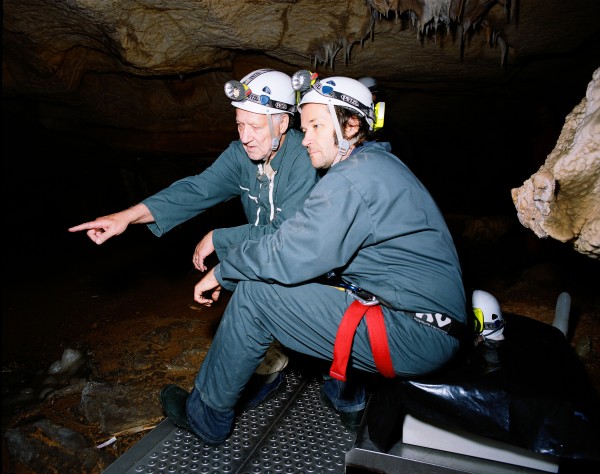TORONTO — Something like 20,000 years ago, a rock slide sealed up the entrance to a large cave set into a limestone cliff above the Ardèche River in southern France. No human being entered it again until 1994, when a trio of explorers wedged themselves through a tiny aperture and made one of the most extraordinary discoveries of cultural history: Chambers upon chambers of spectacular prehistoric art, both figurative and abstract, including images of many extinct species of Ice Age animals. You and I will never see any of this, except with the help of Werner Herzog’s strange, flawed and mesmerizing 3-D film “Cave of Forgotten Dreams,” which premiered at the Toronto International Film Festival on Monday night.
Let me go over that again briefly: Yes, Werner Herzog has made a movie in 3-D that’s largely set inside a cave full of Stone Age art. His producer, Erik Nelson — who is a friend and an occasional Salon contributor — says that Herzog is the first director of the new 3-D wave to use the technology for good, not for evil. Secondly, yes, the art is beautiful, even stunningly accomplished, and these images are breathtaking — unlike anything you’ve seen before or will see again. And thirdly, yes, “Cave of Forgotten Dreams” will become a classic drug movie almost immediately, although the experience is mind-altering enough without any augmentation.
What’s now known as the Chauvet Cave (after Jean-Marie Chauvet, leader of the exploring party) was promptly seized and sealed by the French government; more people have visited the summit of Everest since 1994 than have seen the interior of the cave. Much of the struggle for Herzog and Nelson was getting in there in the first place. Beyond the 400 or so Paleolithic cave paintings in pristine condition, and the important artifacts and fossils (cave-bear skulls! cave-bear scratches!), Chauvet has far-reaching implications for the study of cultural prehistory and the birth of human consciousness. These paintings are roughly twice as old as any other known examples of pictorial art. (The earliest of them may go back 33,000 years.) They’re as close as we can come, at least for now, to the dawn of art.
If you had to nominate one filmmaker to explore this astonishing underground world for posterity, then the legendary cinematic madman and visionary who once ordered a passenger ship pulled over a mountain might well be your choice. Herzog has never been daunted by logistical challenges, and from his early career in Germany through documentaries like “Encounters at the End of the World” and “Grizzly Man,” his work has been infused with what you might call an atheistic spirituality. He’s always fascinated by the kinds of unanswerable questions about human nature and the human soul that Chauvet seems to pose.
Getting into Chauvet and out again with these amazing pictures is really quite enough: The overlaid quartet of horses! The pair of battling woolly rhinos! The running bison, flowing with the contours of the cave wall! It’s a gift to humanity, one that all on its own places this among Herzog’s most important films. Watching “Cave of Forgotten Dreams” is an interactive experience, and not in the bogus computer-game sense. I guarantee you will exclaim out loud, ooh and ahh, feel shivers of recognition go down your spine.
I’ll leave a fuller consideration of “Cave of Forgotten Dreams” for another time, since it has no distributor or release date. For now, I’ll merely add that I wish our willfully eccentric German cave guide indulged in a little more of his customary philosophical speculation, and wasn’t so easily distracted by former circus performers, fur-clad scientists who can play the “Star-Spangled Banner” on a vulture bone, and albino crocodiles. (You think I’m kidding about the crocodiles.)
Scientists are supposed to avoid guesswork and supposition, but filmmakers aren’t. To me Herzog’s claim that the world of Chauvet is lost and unknowable simply isn’t true. (In other words, his title is wrong.) OK, we’ll never know what language they spoke in 31,000 B.C., or hear the stories they told around the fire. But what makes Chauvet so striking, I think, is that on a species-instinct level, we recognize it immediately. It’s the place where those stories got shaped and told, the place where one generation passed along its symbolic understanding of the universe to the next. My first thought was: It’s the first cathedral ever built, and the ones in Chartres and Salisbury are just later versions of the same thing. You might prefer to call it a theater or an art gallery or a dance hall instead; I suspect it comes to the same thing in the end.

